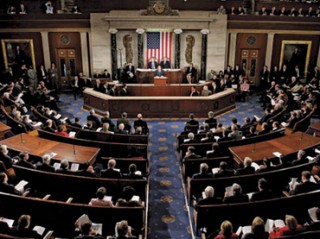Congress closed its 2010-2012 session by passing a fiscal package that delays deep cuts to the defense budget and other executive branch agencies for two months, averting the “fiscal cliff” that threatened to slash nearly $50 billion from DOD’s 2013 appropriations ledger.
The negotiations offered a very public look at the high-drama posturing that has become a hallmark of dealings between the White House and Capitol Hill. To many casual observers, the back-and-forth signaled a new low in relations between the two branches, but to many on the inside, it was symptomatic of the legislative process that grinds on every day, usually outside of public view.
The hard work of crafting bipartisan legislation may take months of talks behind closed doors but produce only a few days of newsworthy drama. The annual National Defense Authorization Act (NDAA) is one of those must-pass measures that enjoy overwhelming bipartisan support but take months of meetings, briefings, hearings and tense negotiations among members of the House and Senate from both sides of the aisle and DOD. The Hill and Pentagon trade budget requests, legislative proposals, cost estimates, testing data, planning documents and long-term strategy to craft each year’s spending priorities and an overarching national-security policy. The House Armed Services Committee (HASC) leads the four defense committees each year, followed by House and Senate Defense Appropriators — the HAC-D and SAC-D — and finally the Senate Armed Services Committee — SASC.
The annual defense authorization and appropriations processes begin with the delivery of the President’s Budget Request (PB), usually in early February. That contains DOD spending priorities for the next fiscal year and lays out planned spending for the following five years. The four committees examine the budget requests and convene hearings, where the service chiefs and secretaries, combatant commanders (COCOMs) and other key contributors to U.S. defense strategy and policy testify on the current state of play within each of the armed forces branches and COCOM areas of responsibility.
The series of annual inquiries are called posture hearings, and they are usually kicked-off in mid-February by the Secretary of Defense (SECDEF) and the Chairman of the Joint Chiefs of Staff (CJCS), who testify to the contents of the entire proposal for DOD and national security accounts at the Department of Energy. The SECDEF and CJCS also layout long-term strategic priorities for DoD, such as the shift of assets and resources to the Asian-Pacific region. Committees cram dozens of hearings into full committee and subcommittee sessions over the course of several weeks, providing Members with an opportunity to ask DOD leaders questions about their priorities. These posture hearings, which are held by all four of the defense committees around the same time, yield critical details that underpin DOD’s voluminous budget request.
Another source of information for staffers is hundreds of pages of support documentation that arrive with the proposal from the Pentagon’s comptroller. These documents, called Justification Books — J-Books for short — support the administration’s position and provide staffers with a wealth of information on individual line items and specific programs. Staffers use the half-dozen or so volumes to craft policy proposals and shape spending accounts.
Defense staffers — called professional staff members on committees of jurisdiction and military legislative assistants (MLAs) in individual member offices — also use data gathered through meetings with COCOMs, base commanders, program executives, the department’s independent office of test and evaluation and defense contractors to develop policy positions to be included in the NDAA. Leveraging site visits, classified threat assessments, and proposed future force planning, staffers begin the work of writing the complex, 1,000-plus page legislation and report.
Between February and March, House members may choose to submit requests that include spending proposals, policy provisions and reporting requirements to the committees of jurisdiction. The Senate sets similar deadlines. The so-called earmarking process continues to be commonplace, despite congressional rules approved four years ago banning the practice. Earmarks, in general, have received far less criticism within defense circles that view the spending and policy adds as useful tools for fielding needed platforms. Unmanned aerial vehicles, cruise missiles, new body armor and hundreds of other battlefield systems, all of which were developed or procured using earmarks, are now commonly lumped together with pet projects and bridges to nowhere.
House member requests are typically submitted by mid-March, giving staff members a month or so to finish cobbling together the bulk of the NDAA, leading up to subcommittee mark-up sessions in April. The schedule in the Senate is usually far less predictable.
HASC subcommittees hold their mark-ups over the course of one week, with few, if any, contentious debates. In years past, the HASC subcommittee marks rarely stretched longer than one hour and frequently wrapped-up in less than 30 minutes. Controversial debates are reserved for full committee consideration a week or two later.
The process for full committee mark-up also differs among the defense panels, with House and Senate authorizers drawing the most attention. Appropriators usually hold mark-up sessions behind closed doors. The HASC holds a marathon one-day session in early May that can last more than 12 hours, stopping only briefly for floor votes and lunch. The final House bill heads to the floor a week later.
The SASC splits its mark-up over two or three days, occasionally going longer, but the resulting bill can stay at the Committee level for months before being sent to the Senate Floor for a vote, as evidenced by the FY’2013 bill that sat idle well into the lame duck session.
Even while the four committees use their own processes to develop their bills, members and staff frequently reach across the aisle and between chambers to build coalitions, answer member questions, push back on criticisms and pre-empt veto threats from the executive branch. Once versions of the bill pass in both the House and Senate, the process of negotiating a concensus compromise begins.
Staffers from the authorizing and appropriating committees go back and forth on the laundry list of differing positions, settling most through the day-to-day horsetrading that goes into such large, complex bills. Measures carried in one house and not the other are frequently set aside for deals on bigger issues of more importance to the committee’s top leadership. At the end of staff-level talks, remaining issues are elevated to the chairmen and ranking members to work through at the member level. Compromise on these remaining issues can be illusive, and disagreements do not always break along party lines, forcing committee leaders to find compromises between strong, but differing, House and Senate positions.
Despite the difficulty that members seem to have agreeing to compromise legislation on fiscal issues, the defense committees are able to artfully craft and pass language each year that accounts for more than half of the government’s total discretionary budget and hundreds of projects and programs. Even with controversial, politically-charged national policy questions on the docket, such as the wars in Iraq and Afghanistan, detainees and TRICARE benefits, the two chambers consistently approve the NDAA with an overwhelming, bipartisan majority.
Even as the debate over tax increases and spending cuts has dragged on publicly for nearly two years, House and Senate members and staffers continue to work and negotiate behind the scenes with DOD and the White House to constructively shape our nation’s long-term national security policy. As the new Congress continues work on an evasive fiscal deal, negotiators could learn a lot from the process lawmakers and defense officials use every year.





